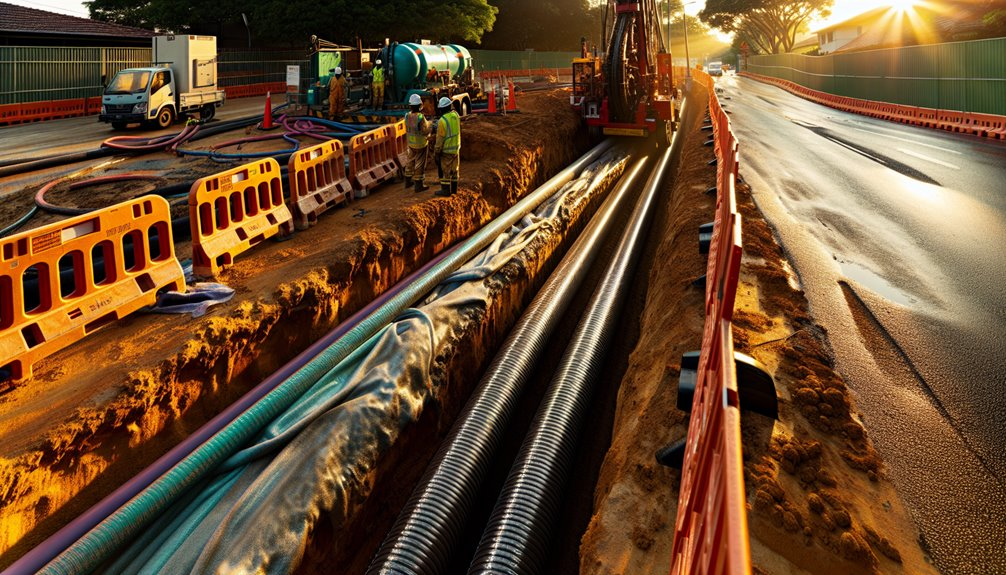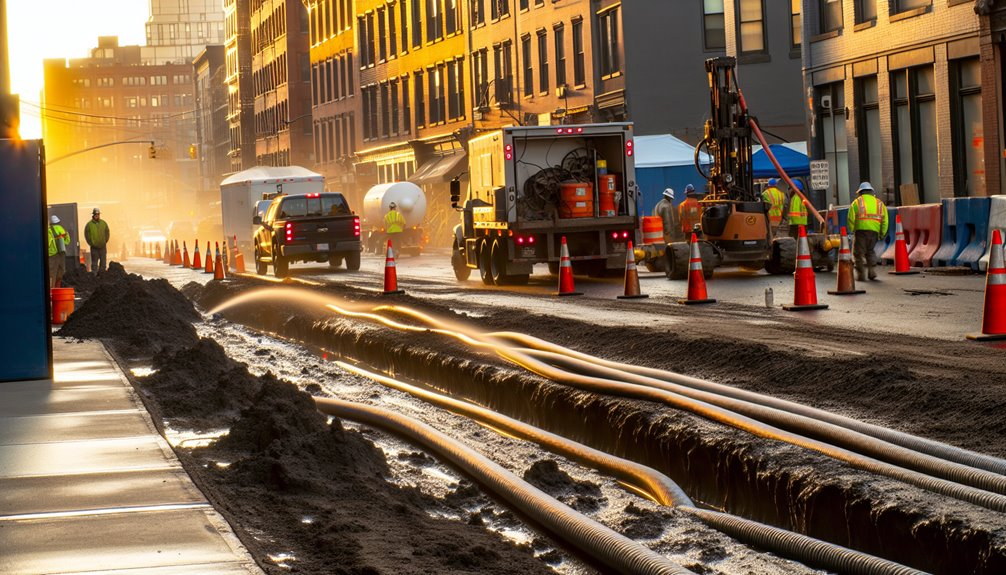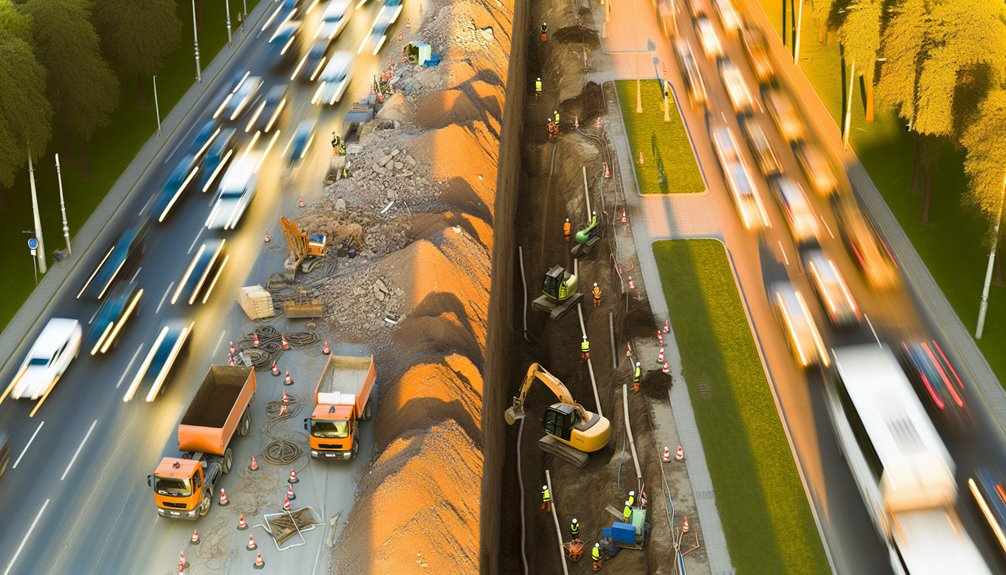You can upgrade water mains with horizontal directional drilling to cut traffic closures, avoid sensitive utilities, and control restoration costs. Plan the route with utility QL-A/QL-B data, secure permits, and set acceptance criteria per AWWA and ASTM. Pair geotechnical borings with drilling-fluid design to manage loss and annular pressure. Stage pilot, ream, and pullback with gyro verification, then hydrotest. The right pipe, crews, and schedule make the difference—but only if you avoid common pitfalls.
Why Horizontal Directional Drilling Suits Water Line Projects
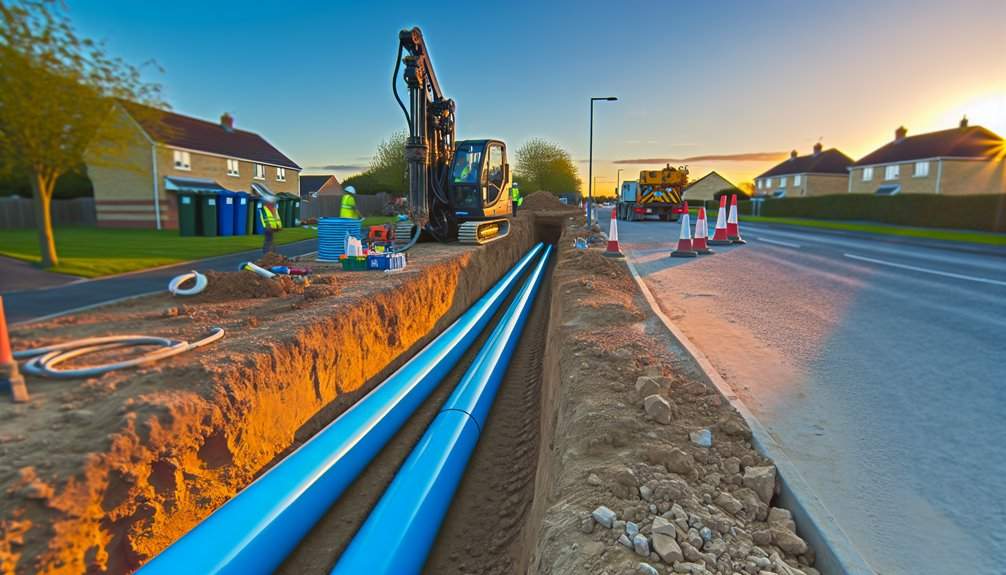
From congested corridors to sensitive habitats, horizontal directional drilling (HDD) delivers controlled, trenchless installation that minimizes surface disruption while meeting utility standards.
You reduce lane closures, avoid open-cut permits, and maintain service continuity while hitting alignment tolerances for potable water mains.
HDD suits utility crossings under highways, rail, and waterways where clearances, cover, and separation distances are regulated.
You can specify fused HDPE or PVC C900 with restrained joints and verify bending radii within manufacturer limits.
Geotechnical data guides bore path selection to manage hydrofracture risk and annular pressure.
You’ll document as-built coordinates, install locator trace wire, and meet AWWA and local specs.
Commissioning includes pressure testing to confirm integrity, followed by disinfection and bacteriological sampling to certify readiness and protect public trust.
How HDD Works From Pilot Bore to Pullback
With HDD selected for its control and compliance, the construction sequence starts with a guided pilot bore, enlarges the path with staged reaming, and finishes with product pipe pullback under monitored loads.
You establish pilot alignment using walkover, wireline, or gyro tools, recording depth, azimuth, and bend radii to meet AWWA and ASTM tolerances.
You verify drilling fluid properties (density, viscosity, sand content) to maintain bore stability and cuttings transport.
You execute a reaming strategy in calibrated passes, increasing diameter 25–50% per stage, holding annular velocity and torque within target windows.
Swab passes condition the bore and confirm returns.
For pullback, you connect the product via swivel, track tensile load and pressure against pipe rating, maintain buoyancy control, and document as-built data for QA/QC and stakeholder confidence.
Site Selection and Route Planning for Success
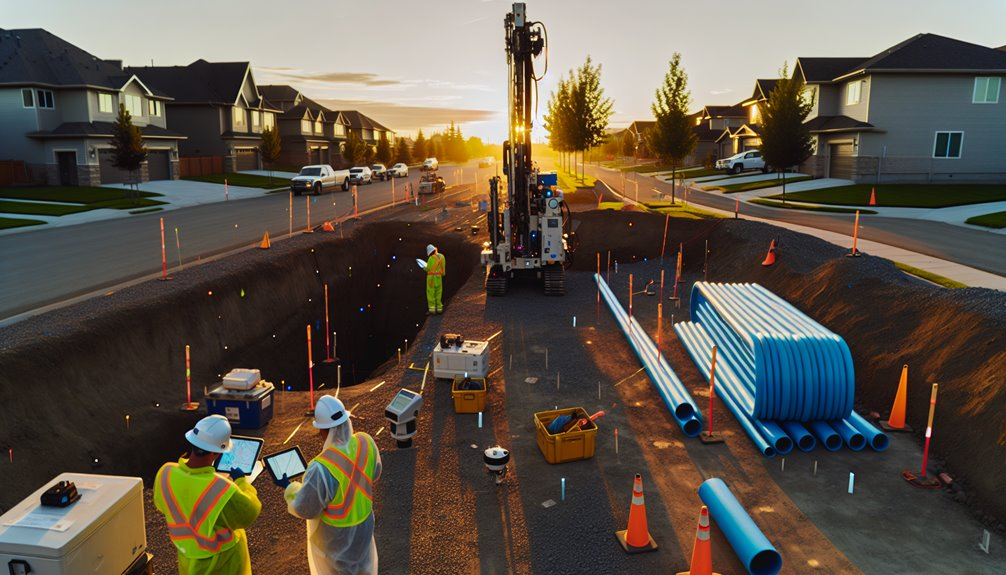
Before committing to HDD, you evaluate corridors using utility maps, one-call locates, potholing results, and subsurface utility engineering (ASCE 38 or ASCE 75) to reduce strike risk and conflicts. You align the route with Right of Way mapping, traffic control needs, and setback constraints, verifying clearances to existing assets through disciplined utility coordination. You confirm drill entry/exit pads, fluid management zones, and staging that respect residents, businesses, and environmental buffers. Then you select a path that meets hydraulic objectives, minimizes curvature, and preserves restoration budgets.
- Quantify minimum separations, bore depths, and bend radii; document acceptance criteria.
- Validate access for rods, reamers, and carrier pipe; check crane and truck turning templates.
- Coordinate shutdowns and tie-ins with operations to limit service disruptions.
- Secure permits, easements, and notifications on a unified schedule.
Geotechnical Investigations and Risk Management
Although route planning narrows the corridor, you still need a geotechnical program that characterizes subsurface conditions to a level commensurate with HDD risk.
You’ll scope borings, test pits, and cone penetration tests to define soil stratigraphy, shear strength, and plasticity. Pair lab testing (grain size, Atterberg limits, UCS) with groundwater monitoring to capture seasonal variance and artesian potential.
Map boulders, karst, debris, and utilities using geophysics where visibility is limited.
Quantify drilling fluid loss risk, hydrofracture pressure windows, and annular pressure margins.
Develop a risk register: assign likelihood, consequence, and controls (contingency alignments, fluid additives, frac-out response).
Calibrate design inputs with ASCE/NASTT guidance, then brief stakeholders on trigger thresholds and stop-work criteria so your team acts decisively together.
Equipment, Materials, and Pipe Selection
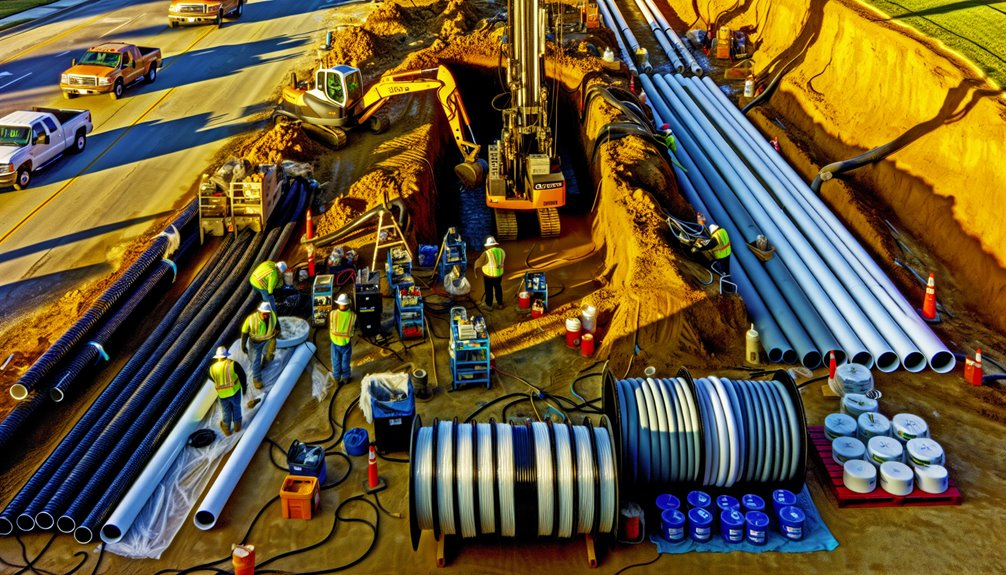
Select HDD equipment and pipe based on quantified loads, ground conditions, and project constraints established in design. Match rig thrust/rotary torque to calculated pullback with safety factors per ASTM F1962. Specify reamers and steering tools for soil classification; verify annular pressure limits to protect overburden. Engineer drilling fluids by rheology and return rates to maintain bore stability and cuttings transport. Choose PE4710 or steel based on pressure class, bending radius, and abrasion; qualify fusion welding per ASTM F2620 with bead inspection and tensile coupons. Standardize fittings, tracers, and isolation valves to your utility’s specifications.
1) Confirm minimum bend radius exceeds predicted bore curvature.
2) Size product pipe for surge and water-hammer.
3) Validate pulling heads and swivels for axial load.
4) Document as-built forces and fluid volumes.
Environmental and Community Benefits
While open-cut replacement disrupts streets and habitats, HDD reduces surface disturbance, emissions, and community impacts by limiting excavation footprints and construction duration.
You minimize pavement demolition, tree removal, and utility conflicts by confining work to entry/exit pits and a controlled bore path. Field data show lower particulate generation and fuel use when compared to trenching, supporting municipal air-quality goals and climate commitments.
You also deliver reduced noise through smaller work zones and shorter active windows, improving livability near schools, clinics, and residences.
HDD supports wildlife protection by avoiding riparian crossings and timing bores outside sensitive breeding seasons per state and federal guidance.
You can implement frac-out monitoring, drilling-fluid containment, and water-quality sampling to meet NPDES, ESA, and local stormwater standards, reinforcing trust with regulators and neighbors.
Cost, Schedule, and Quality Considerations
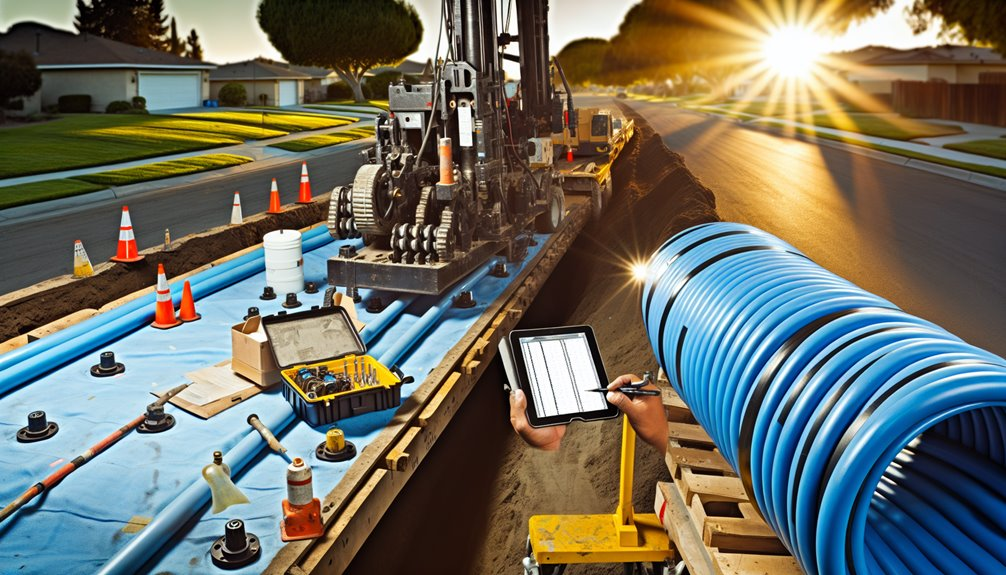
Building on reduced surface disturbance and regulatory alignment, you also gain measurable advantages in cost, schedule, and delivered quality with HDD. You standardize estimating with unit-rate drilling metrics, track crew productivity, and align budget forecasting to ASTM F1962-based design inputs. You compress durations through timeline optimization, leveraging parallel activities—pilot, reaming, and pre-assembly—while minimizing traffic control and restoration risk. You enhance quality by verifying bore path with gyro or walkover systems, pressure-testing per AWWA C600/C605/C906, and documenting as-builts via GIS.
1) Define scope using geotech data, strike avoidance, and pullback force models.
2) Baseline costs with productivity curves, fuel factors, and contingency by subsurface class.
3) Sequence work to reduce idle time and permit gaps.
4) Validate installation with hydrostatic tests and SDR conformance.
Case Applications and Lessons Learned
Although every alignment has unique constraints, recent HDD water main projects show repeatable patterns you can leverage: a 1,200‑ft, 16‑in DR11 HDPE river crossing reduced open‑cut impacts to zero in the floodway, held annular pressures below 10 psi using a thixotropic mud program, and achieved a 1.1:1 productivity factor versus ASTM F1962 pullback predictions; a downtown 8‑in DI pipe installed via HDD under PCC pavement met AWWA C600 hydrostatic criteria after a two‑stage ream and swab, cutting traffic control by 60% and restoration costs by 35%; a coastal site with running sands required real‑time EDR log review and an adjusted reaming sequence (12→18→24 in) to maintain frac‑out risk below 5% per IR plan thresholds.
You’ll translate these outcomes into pre-bid risk registers, contingency for unexpected obstacles, and maintenance planning.
Standardize annular pressure limits, IR compliance steps, and QA hold points.
Tie mud rheology targets to geotech logs.
Validate pull forces against F1962.
Calibrate ream sequences from EDR data.
Align hydrotest criteria with AWWA standards.
Embed lessons in your specifications, bid forms, and after-action reviews so the whole team advances together.
Conclusion
As the owner of Boring Bros., I’ve seen how HDD upgrades can save communities time, money, and hassle by minimizing surface disruption while meeting AWWA and ASTM standards. When we combine careful utility mapping, optimized routing, and the right permits with solid geotechnical data, drilling-fluid design, and annular pressure control, we avoid conflicts and manage losses and heave. Our teams execute precise pilot, ream, and pullback operations with gyro/walkover verification, then complete hydrotesting and disinfection per AWWA C600/C651 equivalents for PE and steel. We also capture metrics, lessons learned, and unit costs to keep improving specifications, procurement, and risk-adjusted schedules. If you’d like to learn more or discuss a project, I’d love to hear from you — visit boringbro.com or call us at (954) 639-6167.

